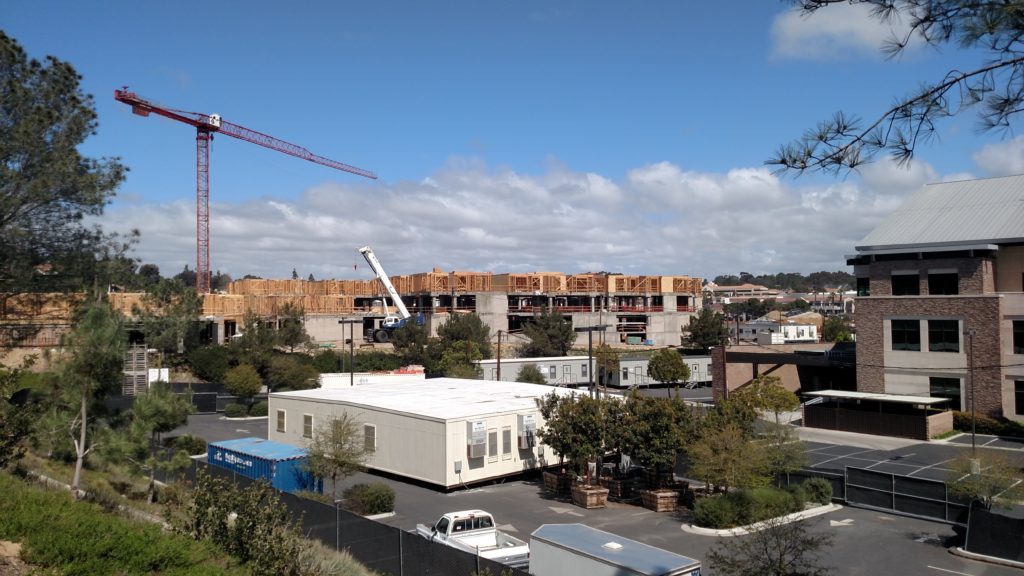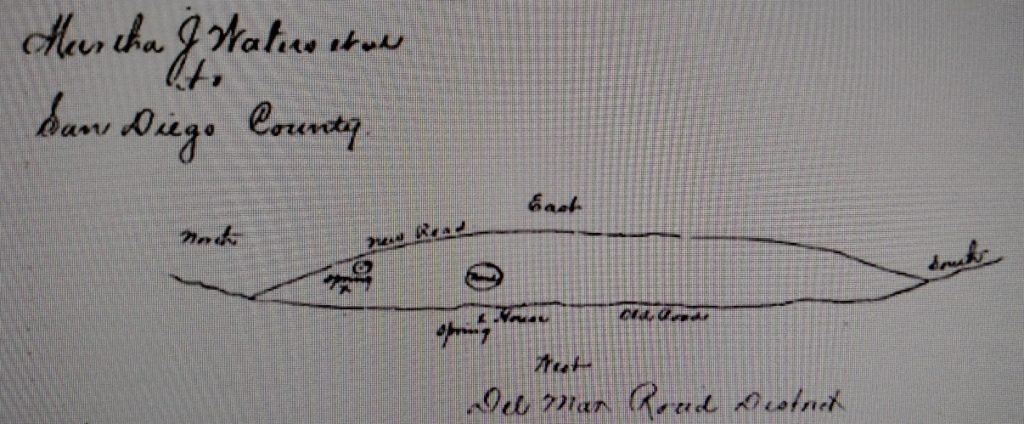Before the railway arrived in the early 1880s, travel between San Diego and other California destinations was either by sea or over the trail that once connected it to the other California missions and pueblos, now called El Camino Real but also known at different times as Fremont’s trail, Kearny’s trail, the Los Angeles road and the Temecula road. In 1868 Alfred Seeley began operating stagecoaches from Old Town to Los Angeles over this route, at first weekly, then, by 1871, six days a week. In 1869 Seeley acquired the former Bandini adobe in Old Town, added a second story, renamed it the Cosmopolitan Hotel, and used it as the San Diego terminus of the Seeley stage line.
The trip from San Diego to Los Angeles covered about 130 miles and took two days, including an overnight stop in San Juan Capistrano. The passengers rode in the same coach for the entire journey but the horses had to be exchanged for a fresh team at regular intervals, so stage stations with barns or corrals for horses and dining facilities for passengers grew up along the way. The first relay of horses leaving the Cosmopolitan Hotel were ready for replacement by the time they reached the Sorrento Valley area, where the stage station was operated by Ellar McKellar.
McKellar was born in Scotland in 1841 and served in an Ohio cavalry regiment in the American Civil War. After the war he re-enlisted in the army and served three years during the Indian wars. After his discharge in 1868 he ended up in San Diego where in 1871 he married and became a naturalized citizen. McKellar first kept Seeley’s horses in Sorrento Valley but in 1874 he moved a few miles further north, near the divide between the Sorrento and San Dieguito River valleys, to a place known as Cocktail Springs. In 1876 he filed a homestead application for the property, in Section 18 of Township 14 South, Range 3 West. According to Del Mar historian Nancy Ewing there was already an adobe structure on the property but McKellar added a dining room and kitchen for travelers and also built a blacksmith shop and corral for horses. A delinquent tax list published in the Union in 1879 listed 40 acres of government land about 1 mile north of Cordero Valley, known as Cocktail Springs and claimed by E. McKellar, with a valuation of $50 and with $50 in improvements (Cordero Valley is now known as Carmel Valley, after a group of Carmelite Sisters of Mercy who settled there in the 1890s).
John Davidson, the first curator of the San Diego Historical Society’s Junipero Serra Museum, speculated in a 1934 article in the Evening Tribune that Cocktail Springs was the medium-sized pool of fresh water that the diarist of Governor Portola’s overland journey from San Diego to Monterey had reported in 1769 at the end of the valley about half a league north of Sorrento Valley. Davidson’s article was accompanied by photos of the adobe buildings still standing at Cocktail Springs in 1934.
The stage station at Cocktail Springs did not serve travelers for very long, however. The California Southern Railroad began laying track north from National City in 1881 and the tracks had reached Oceanside by the end of the year, then continued to Colton and, by 1885, a connection with a transcontinental rail line at Barstow. From San Diego to Oceanside the railway paralleled the route of the Seeley stage line, and was far faster and more comfortable, so stagecoach travel, and the stage station at Cocktail Springs, soon became obsolete. Ellar McKellar remained on the land and in November 1884 his homestead claim, No. 1731, was ‘established and duly consummated’ and he was awarded a patent for the SE ¼ of the NW ¼, the N ½ of the SW ¼ and the SW ¼ of the SW ¼ Section 18, Township 14 south, Range 3 west, 161 and 62/100 acres centered around the present-day intersection of El Camino Real and Del Mar Heights Road.
Ellar McKellar did not farm his homestead for long either. In September 1885 the San Diego Union reported that a man had fallen or jumped into San Diego Bay from the Steamship Company’s wharf, and despite the efforts of a bystander and the crew of a passing schooner to save him he had sunk, leaving a hat and an empty leather purse in the water. A fisherman who had seen him go out on the wharf reported that he had been whistling ‘The Ship That Never Returned’.
A few days later the Union reported that the man who drowned in the bay had been identified by his wife from the hat and purse recovered from the water. The Union interviewed the wife and learned that the drowned man was Ellar McKellar, who had resided in the San Dieguito Valley at a point known as Cocktail Springs and had a farm of 160 acres. Mrs. McKellar also told the Union that he sometimes drank very heavily but had not been on a spree for six or seven months. She usually came to the city with him to keep him from drink – he never drank at home – but he had left earlier in the week with a two-horse team to bring some farm products to market. He had received six dollars in money and with that must have got drunk.
The next day McKellar’s body was recovered from the bay and identified by Mrs. McKellar, and a coroner’s inquest brought in a verdict of accidental drowning. The Union noted that he had many friends who looked upon him as a jolly Scotchman, possessing many excellent qualities and one fatal vice, but he hadn’t known when he walked along the wharf merrily whistling ‘The Ship That Never Returned’ that it was waiting for him with black sails set.

In March 1886 McKellar’s estate, the acreage around Cocktail Springs and personal property including two horses, one wagon, one barrow, one plow, one set of harness, two goats, one colt, carpenter’s tools, three dozen chickens, one hog, one ton of hay and one lot of household property, was assigned to his widow, Eliza. In March 1887 Eliza McKellar acquired another 160 acres in Section 19, south of and adjoining the homestead in Section 18. Over the next few years she sold off both of these properties in 40- and 80-acre parcels. The last parcel to be sold, to Martha Waters in March 1893, was the NW ¼ of the NW ¼ of Section 19 and the SW ¼ of the SW ¼ of Section 18, the 80 acres surrounding the springs and stage station and traversed by the old stagecoach road.
Later In 1893 Martha and B. J. Waters granted the county an easement of right-of-way for a new public road over this property, changing the route of what they called the ‘old Temecula and San Diego road’. The new road would be fifty feet in width and would leave the old road about 190 feet north of Cocktail Springs and rejoin it about 420 feet south of Cocktail Springs, being about 700 feet long and running about 90 feet from the existing road in a curve, as shown in a ‘rough diagram’ included in the deed. This bend in the county road that became known as El Camino Real remained for more than 80 years.
Cocktail Springs was not in the news much after the stagecoaches stopped visiting. In 1899 the Union reported that Mr. Froehlich of Miramar was opening a blacksmith shop at the old stage station, known as Cocktail Springs, on the county road. In 1941 an ad in the San Diego Union offered Cocktail Springs Rancho for sale; ‘One mile east of Del Mar; 73 acres; beautiful large trees; 2 springs; old adobe ruins; 30 acres in black-eyed beans; ideal horse ranch: price $5500’. It was for sale again in 1947 as Historical Cocktail Springs Rancho, 73 acres at $200 per acre, 1 mile east of Del Mar, 1st stage stop on El Camino Real. It was ideal for a horse or dude ranch with many huge trees and adobe ruins. A portion of the ranch was listed again in 1957 as a 3-B.R. 2 bath on 3 acres (historically known as Cocktail Springs); ‘trees, natural beauty, quiet pet pony stays’. The 3-bedroom house was probably not the adobe ruin; in 1955 John Davidson’s wife Winifred, herself an eminent historian and a founder of the Historical Society, wrote in the Union that the last time they visited Cocktail Springs the only reminder of the old days was the huge eucalyptus with pock-pitted bark shadowing Fremont Trail (although Nancy Ewing wrote that the adobe ruins remained into the 1970s).

In the 1970s San Diego’s growth extended to what was then called North City West, the area between the Sorrento and San Dieguito River valleys east of Interstate 5, now called Carmel Valley and home to tens of thousands of residents. El Camino Real was realigned and widened into a major thoroughfare through Carmel Valley, obliterating any sign of the original road. Residential neighborhoods were built in the area around El Camino Real and Del Mar Heights Road during the 1980s and in the 1990s a major shopping center was built south of Del Mar Heights and east of El Camino Real. The property southwest of this intersection, where the stage station had once stood, was also graded but then sat vacant for decades. A biosciences company campus was built on a portion of the site in 2004 and just last year construction began on the One Paseo mixed-use project on the remaining 23 acres. Scheduled to open in 2019, One Paseo will include over 600 apartments and condominiums, over 95,000 feet of retail space, 280,000 square feet of office buildings and probably a new ‘watering hole’ or two at what was once Cocktail Springs.




